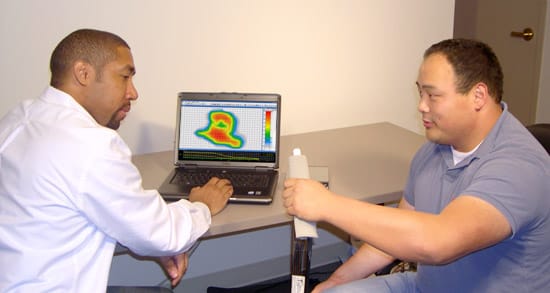Article: ADPonthenet.com
How are mattresses designed for different body types and shampoo bottles shaped to closely match the size of your hand? The answer is the technology of pressure body mapping, a technology that will shortly go on display at one of the newest museums in the USA – the Leonardo in Salt Lake City

A focus group member tests different types of prototype toothpaste packaging with Tactilus®. The pressure to squeeze was measured along the tube, and this data established real quantitative as well as qualitative measurement of squeezing effort, creating a baseline for the packaging specialists.
There’s no doubt that interactive exhibits make learning science fun. One example, dubbed ‘Under Pressure’, demonstrates how pressure between the body and a contacting object – such as a chair – can create pressure points and strain. Sensor Products, which happens to be a specialist in this field, has donated its Tactilus® body mapping pressure system to the Leonardo Museum, in Salt Lake City, Utah, which is currently showing the exhibit at schools and libraries until it opens its doors to the public next year. Joe Andrade, the exhibit developer and a Professor of Bioengineering at the University of Utah, integrated it into a portable kiosk that teaches children and adults about surface pressure body mapping.
In pressure body mapping, sensors collect data from the force exerted by the human body as it touches another surface. This data is then converted into colour-coded body maps that correspond to different degrees of pressure. Armed with this knowledge, designers and engineers modify their products to produce more even distributions of pressure on the human body. By taking the load off the red ‘hot spot’ areas (the locations of greatest pressure), products become more comfortable, ergonomic and efficient.
According to Sensor Products, its body mapping projects have evolved according to the needs of the applications. Mattresses are being customised for different body types; plastic tubes and bottles are being modified to be easier to squeeze, and golfers are changing their swing, seeing how the force of their moving feet affects their shift and balance. “We are delighted to share pressure body mapping with visitors to The Leonardo,” says Sensor Products president, Jeffrey Stark. “This technology is becoming more prevalent and is of increasing benefit.”

A youngster watches how, when seated, his body map changes on the Tactilus® display
Pressure body mapping is helping engineers develop products that are not only more ergonomic but also less expensive to produce. A major consumer toothpaste manufacturer is using the technology to develop optimum tube designs that are capable of dispensing toothpaste within certain force parameters but which are less costly in terms of materials and construction.
The client assembled a focus group to test different types of prototype packaging with Tactilus® and asked the test subjects to squeeze all the toothpaste out of the tube. The pressure to squeeze was measured along the tube, with the common practice of rolling the tube up to exact every ounce of toothpaste also profiled. The project established – for the first time – real quantitative as well as qualitative measurement of squeezing effort, creating a baseline that packaging specialists can use to measure precisely and improve their product standards accordingly.
The Leonardo (www.theleonardo.org) is a science, technology and art centre fostering creativity and innovation in young people and adults. The museum will open its doors for the first time next year on Leonardo da Vinci’s birthday – April 15. Funding for the Under Pressure exhibit is provided by the foundations of the Society of Plastics Engineers and the Utah Science Center.



